ॐ श्री गुरुभ्यो नमः ॐ श्री शिवानन्दाय नमः ॐ श्री चिदानन्दाय नमःॐ श्री दुर्गायै नमः
Source of all Images in this Blog-post : Google Images : ‘Google Image Search’ will reveal the multiple sources of every single image shared here. For more details, kindly see ‘Disclaimer‘
Goswami Tulsidas By Swami Sivananda
Tulasi-Ramayana, popularly known as Ramacharita-Manas : Tulasidas’ Gift to Humanity By Swami Chidananda Saraswathi
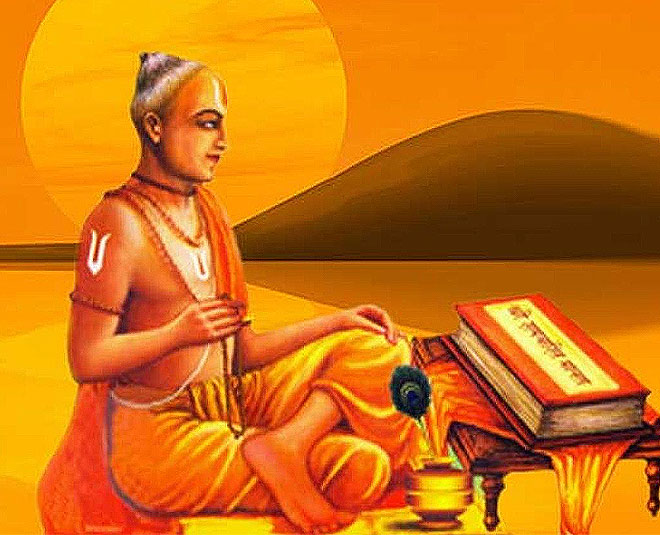
Ramcharitmanas is an epic poem in Awadhi language, composed by the 16th-century Indian bhakti poet Tulsidas (c. 1532–1623). The word Ramcharitmanas literally means “Lake of the deeds of Rama“. It is considered one of the greatest works of Hindu literature.
Look Inside Ramcharitmanas on Amazon India
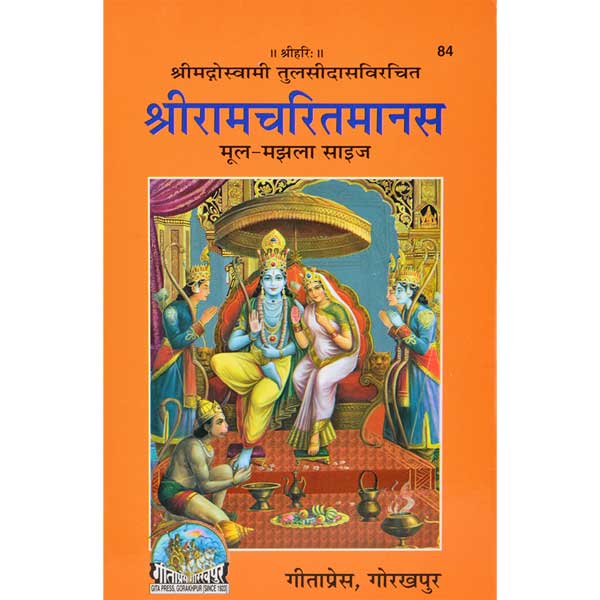
Ramcharitmanas in Indian Regional & Foreign Languages by Gita Press Gorakhpur : Click Here to Explore & Buy
Explore & Buy Online Ramcharitmanas on Amazon India
The work has variously been acclaimed as “the living sum of Indian culture”, “the tallest tree in the magic garden of medieval Indian poetry”, “the greatest book of all devotional literature” and “the best and most trustworthy guide to the popular living faith of the Indian people”.
Read Ramcharitmanas on Goodreads And Google Books
Tulsidas was a great scholar of Sanskrit. However, he wanted the story of Rama to be accessible to the general public, as many Apabhramsa languages had evolved from Sanskrit and at that time few people could understand Sanskrit.
Look Inside Ramcharitmanas on Amazon India
YouTube Videos on Shri Ramcharitmanas : Click Here to Watch
In order to make the story of Rama as accessible to the layman as to the scholar, Tulsidas chose to write in Hindi which was the language of general parlance in large parts of north India at the time.
A YouTube Video : https://www.youtube.com/watch?v=A9tA5XuYJhU&list=PLgYx_VOa-juvyx34j8r2G6cArqVXmVd72
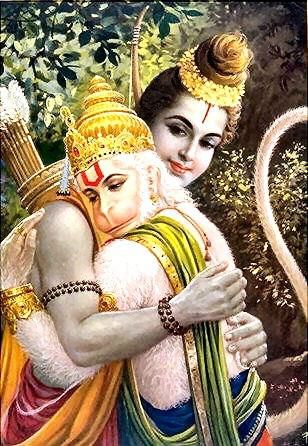
Tradition has it that Tulsidas had to face a lot of criticism from the Sanskrit scholars of Varanasi for being a bhasha (vernacular) poet. However, Tulsidas remained steadfast in his resolve to simplify the knowledge contained in the Vedas, the Upanishads and the Puranas to the common people. Subsequently, his work was accepted by all.
A YouTube Video : https://www.youtube.com/watch?v=dWBZnuyhggo
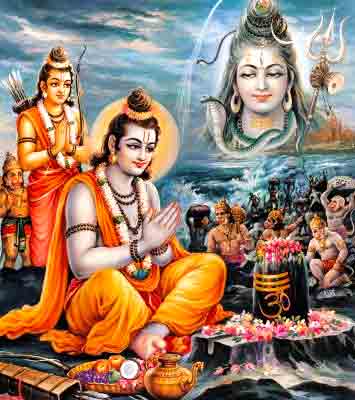
Ramcharitmanas, made available the story of Rama to the common man to sing, meditate and perform on.

The writing of Ramcharitmanas also heralded many a cultural tradition, most significantly that of the tradition of Ramlila, the dramatic enactment of the text.
A YouTube Video : https://www.youtube.com/watch?v=I4QEDN7-vec
Ramcharitmanas in Indian Regional & Foreign Languages by Gita Press Gorakhpur : Click Here to Explore & Buy
Explore & Buy Online Ramcharitmanas on Amazon India
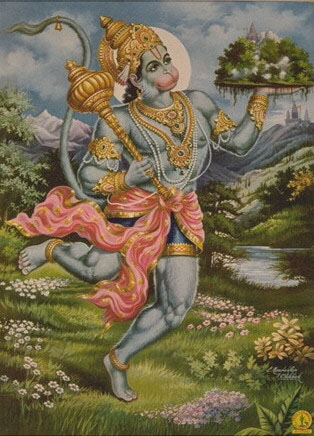
Ramcharitmanas is considered by many as a work belonging to the Saguna school of the Bhakti movement in Hindi literature.

Background
Tulsidas began writing the Ramcharitmanas in Ayodhya in Vikram Samvat 1631 (1574 CE). The exact date is stated within the poem as being the ninth day of the month of Chaitra, which is the birthday of Rama, Rama Navami.
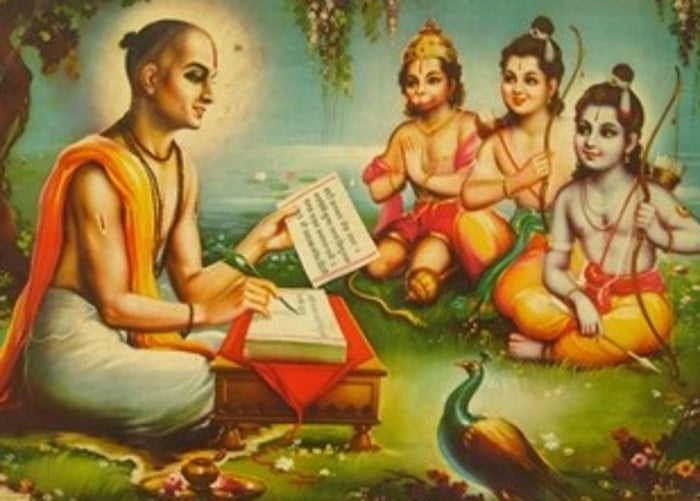
Ramcharitmanas was composed at Ayodhya, Varanasi & Chitrakoot. Akbar the Great (1556-1605 CE) was the Emperor of India during this period.
The Ramcharitmanas is written in vernacular Awadhi language, The core of the work is considered by some to be a poetic retelling of the events of the Sanskrit epic Ramayana by Valmiki.
A YouTube Video : https://www.youtube.com/watch?v=-VNIxG8P9ek
The Valmiki Ramayana is centered on the narrative of Rama, the scion of the family tree of king Raghu of the Sun Dynasty. Rama was the crown prince of Ayodhya and is considered in Hindu tradition as the seventh Avatar of Vishnu.
However, the Ramacharitmanas is by no means a word-to-word copy of the Valmiki Ramayana nor an abridged re-telling of the latter. Ramcaritmanas has elements from many other Ramayanas written earlier in Sanskrit and other Indian dialects as well as stories from Puranas.
Tulsidas himself never writes Ramcharitmanas as being a retelling of Valmiki Ramayana. He calls the epic Ramcharitmanas as the story of Rama, that was stored in the mind (Mānasa) of Shiva before he narrated the same to His wife Parvati.

Look Inside Ramcharitmanas on Amazon India
Tulsidas claims to have received the story through his Guru, Narharidas. Tulsidas was a naive (Acheta) child and the story was stored in his mind (Mānasa) for long before he wrote it down as Ramcharitmanas.
Some understand this passage of the Ramcharitmanas to mean that Tulsidas at first could not grasp the story fully as he was a naïve young boy.
His Guru graciously repeated it again and again so that he could understand and remember it. Then he narrated the story and named it Ramcharitmanas as Shiva himself called it.
The epic poem is, therefore, also referred to as Tulsikrit Ramayana which literally means ‘The Ramayana composed by Tulsidas’.
The Ramcharitmanas is a masterpiece of vernacular literature. Some believe it to represent a challenge to the dominance of high-class Brahmanical Sanskrit, echoing the revolt of Buddha against Brahmanical elitism.
Ramcharitmanas in Indian Regional & Foreign Languages by Gita Press Gorakhpur : Click Here to Explore & Buy
Explore & Buy Online Ramcharitmanas on Amazon India
Structure
Ramcharitmanas consists of seven Kānds which literally means books or episodes. Tulsidas compared the seven Kāndas of the epic to seven steps leading into the holy waters of Lake Manasarovar – the lake that purifies the body and the soul at once.
The first two parts, Bāl Kāṇḍ (Childhood Episode) and Ayodhyā Kāṇḍ (Ayodhya Episode), make up more than half of the work.
The other parts are Araṇya Kāṇḍ (Forest Episode), Kiśkindhā Kāṇḍ (Kishkindha Episode), Sundar Kāṇḍ (Pleasant Episode), Laṅkā Kāṇḍ (Lanka Episode), and Uttar Kāṇḍ (Later Episode).
The work is primarily composed in the Chaupai metre (four-line quatrains), separated by the Doha metre (two-line couplets), with occasional Soratha and various Chhand metres.
Invocations At Beginning of Each Episode
Every chapter of the Ramcharitmanas begins with an invocation or Mangalācharaņ.
It is customary of the Indian tradition of writing that the author begins a new book with invocation to the Gods to ensure that the Sankalpa is finished unhindered.
The first three or four verses of each Kānd are typically in the form of invocations.
Bāl Kāṇḍ begins with a hymn honouring the Hindu Goddess of Learning Saraswati and the God Ganesha. Both the deities are related to knowledge, wisdom, speech and auspiciousness.


Look Inside Ramcharitmanas on Amazon India
Ayodhyā Kāṇḍ begins with the famous verse dedicated to the God Shiva:
‘May He in whose lap shines forth the Daughter of the mountain king, who carries the celestial stream on His head, on whose brow rests the crescent moon, whose throat holds poison and whose breast is support of a huge serpent, and who is adorned by the ashes on His body, may that chief of gods, the Lord of all, the Destroyer of the universe, the omnipresent Śhiva, the moon-like Śańkara, ever protect me.’
Araṇya Kāṇḍ’s first verse again extols Shiva:
‘I reverence Bhagavan Śańkara, the progeny of Brahmā, the very root of the tree of piety, the beloved, devotee of King Śri Rama / Ram, the full moon that brings joy to the ocean of wisdom, the sun that opens the lotus of dispassion, the wind that disperses the clouds of ignorance, who dispels the thick darkness of sin and eradicates the threefold agony and who wipes off all calumny and obloquy.’
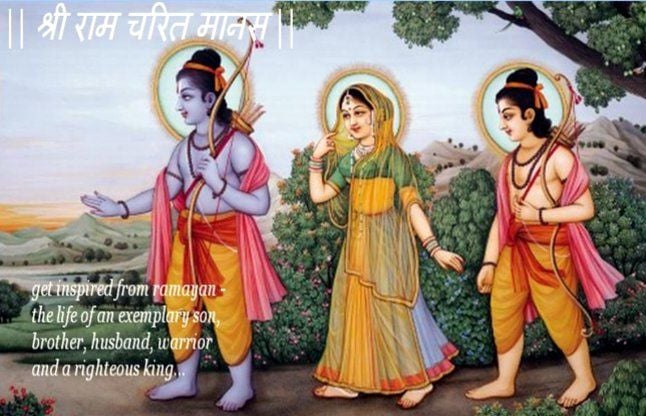

Kiśkindhā Kāṇḍ commences with the following verse:
‘Lovely as a jasmine and a blue lotus, of surpassing strength, repositories of wisdom, endowed with natural grace, excellent bowmen, hymned by the Vedas, and lovers of the cow and Brāhmaņas, who appeared in the form of mortal men through their own Māyā (deluding potency) as the two noble scions of Raghu, the armours of true Dharma, friendly to all and journeying in quest for Sita, may they both grant us Devotion.’
Sundar Kāṇḍ begins with a hymn in the praise of Rama:
‘I adore the Lord of the universe bearing the name of Rama, the chief of the Raghu’s line and the crest-jewel of kings, the mine of compassion, the dispeller of all sins, appearing in human form through His Māyā (deluding potency), the greatest of all gods, knowable through Vedānta (the Upanishads), constantly worshiped by Brahmā (the Creator), Śhambhu (Śivā), and Śeşa (the serpent-god), the one who bestows of supreme peace in the form of final beatitude, placid, eternal, beyond the ordinary means of cognition, sinless and all-pervading.’

Look Inside Ramcharitmanas on Amazon India
Laṅkā Kāṇḍ begins with this hymn:
‘I adore Śri Rama, the supreme Deity, the object of worship even by Śivā (the destroyer of Kāma, the God of Love), the Dispeller of the fear of rebirth, the lion to quell the mad elephant in the form of Death, the Master of Yogīs, attainable through immediate knowledge, the storehouse of good qualities, unconquerable, attributeless, immutable, beyond the realm of Māyā, the Lord of celestials, intent on killing the evil-doers, the only protector of the Brāhmaņas, beautiful as a cloud laden with moisture, who has lotus like eyes and appeared in the form of an earthly king.’




Uttar Kāṇḍ begins with the following hymn:
‘I unceasingly extol Śri Ramā, the praiseworthy lord of Jānakī (Sītā, Janakā’s daughter and the wife of Rama), the chief of Raghu’s line, possessed of a form greenish blue, the color of the neck of a peacock and adorned with an insignia of Brahmā pada, the lotus-foot, which testifies to His being the greatest of all gods-rich in splendour, clad in yellow robes, lotus-eyed, ever-propitious, holding a bow and arrow in His hands, riding an aerial car named Puşpakā, accompanied by a host of monkeys and waited upon by His own brother Lakşmaņa.’
Kānd endings
Tulsidas ends every chapter in a similar manner describing the ending in the Sanskrit language.
Every Kānd is formally concluded by Goswami Tulsidas. The following is an example of the ending of Kiśkindhā Kāṇḍ :
‘Thus ends the fourth descent into the Mānasa lake of Sri Rama’s exploits, that eradicates all the impurities of the kali age.’ Read more on Wikipedia Page of Ramcharitmanas
Ramcharitmanas in Indian Regional & Foreign Languages by Gita Press Gorakhpur : Click Here to Explore & Buy
Explore & Buy Online Ramcharitmanas on Amazon India
